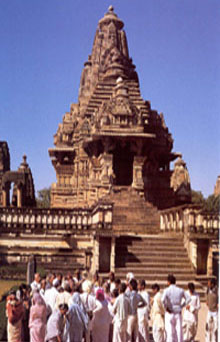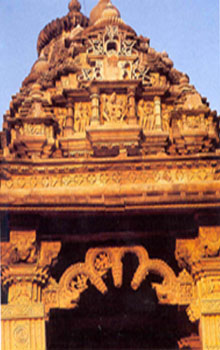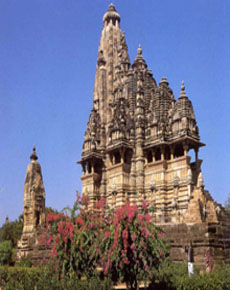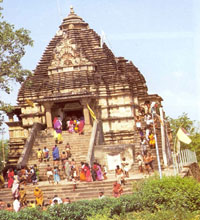The temples of Khajuraho are india's unique gift to the world, representing, as they do, a paean to life, to love, to joy, perfect in execution and sublime in expression. Life, in every form and mood, has been captured in stone, testifying not only to the craftsman's artistry but also to the extraordinary breadth of vision of the Chandela Rajputs under whose rule the temples were conceived and constructed.
The Khajuraho temples were built in the short span of a hundred yeas, from 950-1050 AD, in a truly inspired burst of creativity. Of the 85 original temples, 22 have survived till today to constitute one of world's great artistic winders.
The temples lay forgotten for many centuries, covered by the encroaching forests, victim to the ravages of the elements. Re-discovered only in this century, restored and cleaned, the temples of Khajuraho once again testify to a past glory.
Lakshmana Temple

The large Lakshmana Temple is dedicated to Vishnu, although in design it is similar to the Kandriya Mahadeva and Vishvanath temples. It is one of the earliest of the western enclosure temples, dating from around 930 to 950 AD, and is also one of the best preserved, with a full five-part floor plan and four subsidiary shrines. Around the temple are two bands of sculpture instead of the usual three; the lower one has fine figures of apsaras and some erotic scenes. Inside are excellent examples of apsaras acting as supporting brackets.
On the subsidiary shrine at the south-west corner is an architect working with his students - it is thought this may be the temple's designer including himself in the grand plan. Around the base of the temple is a continuous frieze with scenes of battles, hunting and processions. The first meter or two consists of a highly energetic orgy, including one gentleman proving that a horse can be a person's best friend, while a stunned group of women look away in shock.
Kandariya Mahadev

The first of the temples on the common platform at the back of the western enclosure is not only the largest, it is also artistically and architecturally the most perfect. Built 1025-50, it represents Chandela art at its finest. Although the four subsidiary shrines that once stood around the main temple are long gone, the central shrine is in superb condition and shows the typical five-part design of Khajuraho temples.
The main spire is 31m high, and the temple is lavishly carved. The English archaeologist Cunningham counted 226 statues inside the temple and a further 646 outside - 872 in total with most of them nearly 1m high. The statues are carved around the temple in three bands and include gods, goddesses, beautiful women, musicians and, of course, some of the famed erotic groups. The mithuna on the Kandariya Mahadev include some of the most energetic eroticism to be seen at Khajuraho.
Vishvanath & Nandi

Believed to have been built in 1002, this temple has the complete five-part design of the larger Kandariya Mahadev Temple, but two of its four subsidiary shrines still stand. The large image of Shiva's vehicle, the bull Nandi, faces the temple from the other end of the common platform. Steps lead up to this high terrace, flanked by lions on the northern side and elephants on the southern side.
The sculptures around the temple include the usual Khajuraho scenes, but the sculpture of women are particularly notable here. They write letters, fondle a baby, play music and, perhaps more so than at any other temple, languish in provocative poses.
Matangesvara

Standing next to the Lakshmana Temple, this temple is not within the fenced enclosure because it is still in everyday use, unlike all the other old Khajuraho temples. It may be the plainest temple here (suggesting that it was one of the first built) but inside it sports a polished lingam, 2.5m high.
Early in the morning, flower-sellers do a brisk trade in garlands for the statue of Ganesh outside. People drape them round the elephant-headed statue, say a prayer and as they walk away the sellers whip the flowers off to resell!.
Lakshmi & Varaha
Facing the large Lakshmana Temple are these two small shrines. The Varaha Temple, dedicated to Vishnu's boar incarnation or Varaha avataar, faces the Matangesvara Temple. Inside this small, open shrine is a huge, solid and intricately carved figure of the boar incarnation, dating from around 900 AD.
Chausath Yogoni & Lalguan Mahadev
Standing beyond the tank, some distance from the other western group temples, this ruined temple is probably the oldest at Khajuraho, dating from 900 AD or earlier. It is also the only temple constructed entirely of granite and the only one not aligned east to west. Chausath means 64 - the temple once had 64 cells for the figures of the 64 yogonis who attended the goddess Kali. A 65th cell sheltered Kali herself.
A farther 500m west is the Lalguan Mahadev Temple, a small, ruined shrine, dedicated to the Shiva and constructed of granite and sandstone.
Mahadeva
This small and mainly ruined temple stands on the same base as the Kandariya Mahadev and the Devi Jagadamba. Although small and insignificant compared to its mighty neighbors, it houses one of the Khajuraho's best sculptures - a fine sardula figure caressing a lion.
Devi Jagadamba
The third temple on the common platform is slightly older than the Kandariya Mahadev and of a simpler, three-part design. It was probably originally dedicated to Vishnu, but later dedicated to Parvati and then Kali. Some students believe it may still be a Parvati temple and that kali image(or Jagadamba) is actually an image of Parvati, painted black. The sculptures around the temple are again in three bands. Many of the two lower band images are of Vishnu with sardulas in the inner recesses. But on the third and the uppermost band the mithuna again come out to play.
Chitragupta
The fourth temple at the back of the western enclosure does not share the common platform with the other three. Similar in design to the Devi Jagadamba, this temple is probably slightly newer and is unique at Khajuraho in being dedicated to Surya, the sun god.
Attempts have obviously been made at restoration, but it is not in as good condition as other temples. Nevertheless it has some very fine sculptures, which includes processions, dancing girls, elephant fights and hunting scenes. In the inner sanctum, Surya can be seen driving his chariot and seven horses, while on the central niche in the south facade you can see an 11-headed statue of Vishnu himself; the 10 others are of his incarnations.
Parvati
Continuing around the enclosure, you come to the Parvati temple on your right. The name is probably incorrect since this small and not so interesting temple was originally dedicated to Vishnu and now has an image of Ganga riding on the back of crocodile.
Jain Museum
Outside the Jain enclosure is the modern circular gallery, filled with statues of the 24 tirthankars.



